Cisco Networking Solution Overview
Available Languages
Rapid change is today’s normal. Organizations are evolving their business models and adopting digital approaches faster than ever. Global and regional events are increasing the importance of business agility and resilience to business leaders in organizations large and small.
At the same time, technology does not stand still:
● Technology innovation continues to accelerate — from the emergence of Artificial Intelligence (AI) to the Internet of Things (IoT), multicloud, 5G, ever expanding amounts of data, and increasingly complex cybersecurity threats. Innovations are changing the technology landscape at breakneck speed, creating new opportunities and risks.
● Applications and services are being deconstructed and distributed everywhere inside and outside the traditional enterprise boundaries — from data centers in public-, private-, and hybrid-cloud environments all the way to branch offices and the remote edge. Containers and microservices are being quickly adopted for the greater digital agility they deliver, but they also introduce the opportunity for greater complexity and risk.
● Users and devices are increasingly numerous, diverse, and distributed. The expanding use of diverse IoT devices, applications, and accompanying data is resulting in new distributed compute models, together with exponentially greater levels of scale and complexity. The mainstreaming of the hybrid work model means that workers need secure, reliable access everywhere. Mobile users expect immediate and high-performance connectivity at all times, everywhere, and on any device over Wi-Fi and public 4G and 5G networks.
● Security and compliance are increasingly challenging. Threats are becoming more sophisticated, frequent, and dangerous across a broader attack surface that is no longer contained within well-defined perimeters. Mobility and cloud mean that over 60% of transactions begin or terminate outside the traditional enterprise boundary, leading to the broad adoption of a zero-trust security model.
The need for a new kind of network
In this environment, what should IT leaders be looking for in their new approach to networking? Architectures designed for agility, evolved lifecycle management models, and simpler consumption models to start with.
The traditional rigid and largely manual lifecycle management approach is no longer sustainable for deploying, maintaining, and updating networks, and it cannot scale to meet the growing complexity. For an organization to flourish in the digital economy, the network needs to be able to adapt quickly to changing business requirements or “intent.”
The network needs to support an increasingly diverse and fast-changing set of users, devices, applications, and services. It needs to ensure fast and secure access to and between the increasingly distributed workloads wherever they reside. And for the network to work optimally, all this needs to be achieved securely from end to end, between users, devices, apps, and services across each network domain — campus and branch access, WAN, data center, hybrid cloud, and multicloud. Which means that organizations need to continuously align the network — between users, devices, applications, and workloads everywhere — to application performance and security needs.
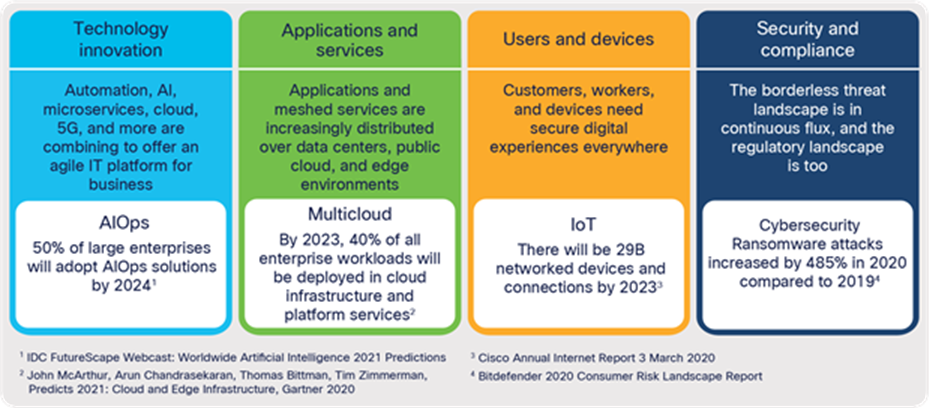
An unprecedented dynamic technology landscape is driving the need for a new networking model
This dynamic business and technology landscape is a reality for all organizations, their employees, and their customers, and is the engine and setting for the digital economy. So IT is feeling the pressure to address all these trends, often with a constrained budget and limited talent pool. Because the network is the common underlying tissue that enables users, devices, and applications to communicate and exchange data in this digital era, IT leaders are recognizing the importance of a drastically new network model.
The new network needs to:
Align to the business
Enable new digital business initiatives, not hold them back. The network needs the agility to quickly and dynamically realign with rapidly changing business objectives or unexpected disruptions.
Deal with growing complexity
Make the network easier to configure, operate, and maintain in the face of growing scale and complexity. Current operational models are not scalable or sustainable.
Assure service performance
Provide full visibility into how the network is operating across private and public internet and cloud networks. Assure that the network is supporting the desired user and application experience, identify any discrepancies, and recommend fixes.
Reduce risk
Adopt a zero-trust model to reduce security threats and identify and neutralize any threats that materialize before they cause harm. Multicloud, IoT, and mobile adoption open up new threat vectors that the network needs to constantly protect against.
Simplify the network lifecycle
Keep pace with your enterprise network’s expanding demands as technologies and requirements change by simplifying and streamlining how you acquire, consume, maintain, and update your network technology.
According to Gartner Research, “We believe a full IBNS implementation can reduce network infrastructure delivery times to the business leaders by 50% to 90%, while simultaneously reducing the number and duration of outages by at least 50%.”
Andrew Lerner, Joe Skorupa, and Sanjit Ganguli
Innovation Insight:
Intent-Based Networking Systems (IBNS)
Gartner, 07 February 2017
The Cisco® Networking portfolio is designed to help IT keep up with all the demands of a modern organization. It’s built around a controller-based Intent-Based Network (IBN) architecture that delivers insights and automation to continuously learn and adapt to your organization’s needs.
Cisco Networking has the breadth and depth to serve the broadest range of networking needs across industries and segments. It spans access, WAN, data center, and cloud environments to interconnect users, devices, applications, and workloads anywhere. And it supports both cloud-based and on-premises management modes.

Cisco Networking: Providing the intelligent network architecture you need to securely connect, secure, and automate your digital business – from user to application in a cloud-first world
With IBN building on Software-Defined Networking (SDN) principles, your network transforms from a hardware-centric and manual approach to a software-centric and fully automated one that adds context, learning, and assurance capabilities. Your intent-based network captures business intent and uses analytics, machine learning, and automation to align the network continuously and dynamically to changing business needs. That means a closed-loop intent-based model that is continuously monitoring and assuring application and network performance requirements while applying and automating user, security, compliance, and IT operations policies across the whole network.
By adopting the Cisco Networking portfolio, you can continuously deliver the consistent and secure networking services required to meet your organization’s most pressing needs:
● Support the future of work: Deliver secure and safe access to applications from home, the office, or wherever else work happens.
● Optimize application experiences: Detect and rectify any degradation in network performance and user experience across private and even public networks.
● Securely expand to multicloud: Enable secure deployment for access to distributed workloads and applications anywhere.
● Accelerate network operations: Simplify and accelerate the complete network management lifecycle with closed-loop automation and insights. Streamline workflows by integrating NetOps into your IT processes.
● Enhance security and compliance: Protect users and applications with zerotrust access. Detect and remediate threats quickly with integrated network telemetry and advanced security analytics.
Cisco Networking enables you to quickly adapt to change, simplify and scale operations, and protect against service degradation and threats. It delivers policy-based automation, integrated security, and AI-enabled analytics in the front. And builds on an open, controller-based platform approach in the back.
Building on a foundation of programmable network devices and open platform extensibility vastly increases the network’s value. It allows you to deploy new and innovative applications, endpoints, processes, and solutions that are required today, as well as those that will be needed in the future. And with a broad ecosystem, it allows you to integrate seamlessly into existing environments and processes.
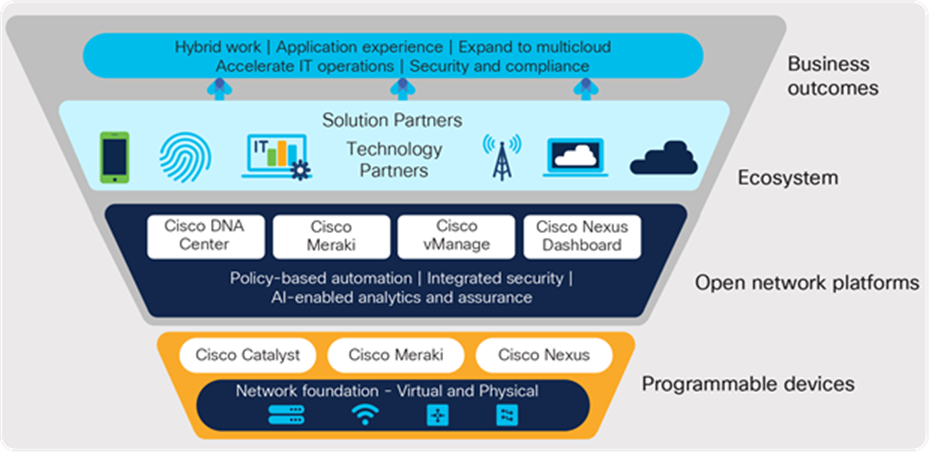
Cisco Networking delivers business outcomes, building on programmable network devices, open platforms, and an extensive ecosystem
Cisco delivers on the vision of applying and assuring intent from client to application by using intent-based networking across all networking domains: campus, branch, WAN, data center, hybrid cloud, and multicloud. Now you can bridge the gap between what your business needs and what your network delivers. Cisco’s intent-based networking solutions connect users from anywhere to applications and services wherever they are hosted.

Architecture and solution suite for Cisco intent-based networking
Table 1. Cisco Networking solutions.
| Solutions |
Platforms |
Network devices |
Software subscription |
| Access networking |
|||
| Cisco Access Networking |
Cisco DNA Center |
Cisco Catalyst® switches, access points, and wireless controllers |
Cisco DNA software |
| Cisco Meraki Access |
Cisco Meraki® |
Cisco Meraki switches and access points |
Cisco Meraki license |
| SD-WAN |
|||
| Cisco SD-WAN |
Cisco vManage |
Cisco Catalyst edge platforms |
Cisco DNA software |
| Cisco Meraki SD-WAN |
Cisco Meraki® |
Cisco Meraki routers, security devices |
Cisco Meraki license |
| Data Center and Cloud Networking |
|||
| Cisco Data Center and Cloud Networking |
Cisco Nexus® Dashboard |
Cisco Nexus switching platforms Cisco MDS SAN switches |
Cisco Data Center Networking software |
Check out the full set of Cisco Networking solutions here.
Getting started with Cisco Networking
Begin your journey to a complete intent-based networking model by deploying solutions that address your most pressing use cases in one or more network domains. Start with any one of the use cases described in this document, or any other use case that drives clear IT and business outcomes.
Enable network access in minutes for any user or device anywhere to any application without compromising security.
● Reimagine connections: Create a pervasive environment for people and things to seamlessly roam and connect without interruption.
● Reinforce security: Enable continuous identity-based trusted access for any users and devices to any data and applications, wherever they are.
● Redefine IT experience: Experience a network built on intent-based networking principles and driven by advanced AI/ML to optimize performance for dense and distributed access environments.
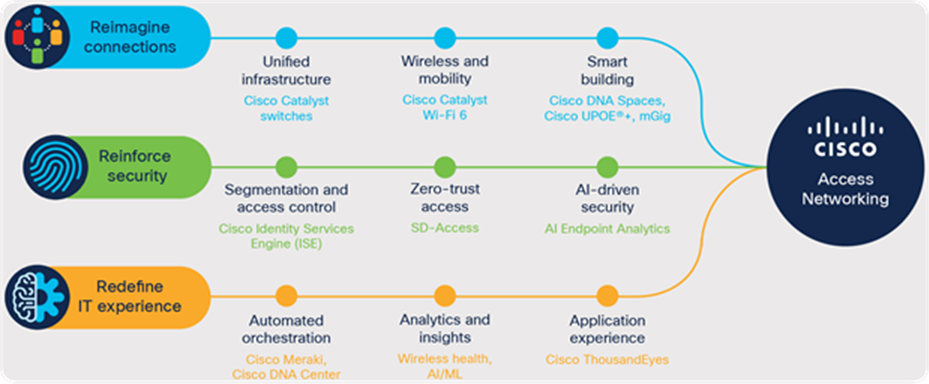
Getting started with Cisco Access Networking
Redefine connectivity and security to connect any user to any application in a multicloud era with a cloud-native SD-WAN overlay built on a Secure Access Service Edge (SASE) enabled architecture.
● Predictable application experience: Increase user productivity and deliver a consistent user experience by optimizing cloud and on-premises application performance.
● Right security, right place: Enable comprehensive on-premises and cloud-based security to accelerate the transition to a SASE architecture where and when needed.
● Deep visibility and insights: Translate real-time actionable insights for better monitoring and management extending beyond your network to the internet and multicloud through native integration with Cisco ThousandEyes.
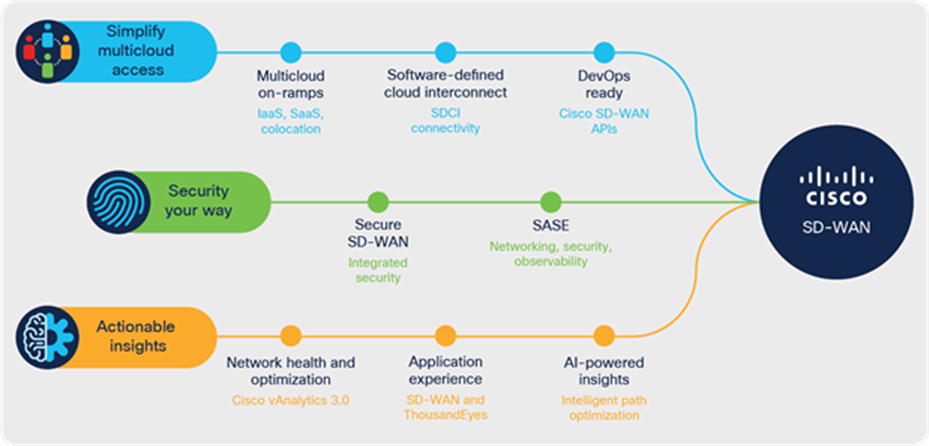
Getting started with Cisco SD-WAN
Cisco Data Center and Cloud Networking
Develop a consistent, automated, agile network operating model for workload mobility and simplicity that extends from on-premises data centers to public clouds and edge environments through a single pane of glass.
● Unified proactive operations: Optimize the application experience and provide unprecedented simplicity by integrating multiple data center operational tools, unleashing best-in-class automation and insights from a single pane of glass to manage, monitor, and troubleshoot the entire network from on-premises to cloud.
● Reduced operational complexity: Provide a simple, uniform onboarding experience for workloads across data center sites and for Cisco and third-party operational services.
● Automated, secure multicloud workloads: Enable an automated policy-based segmentation platform with next-generation firewalls and advanced network analytics and intuitive observability to secure modern data center and cloud environments.
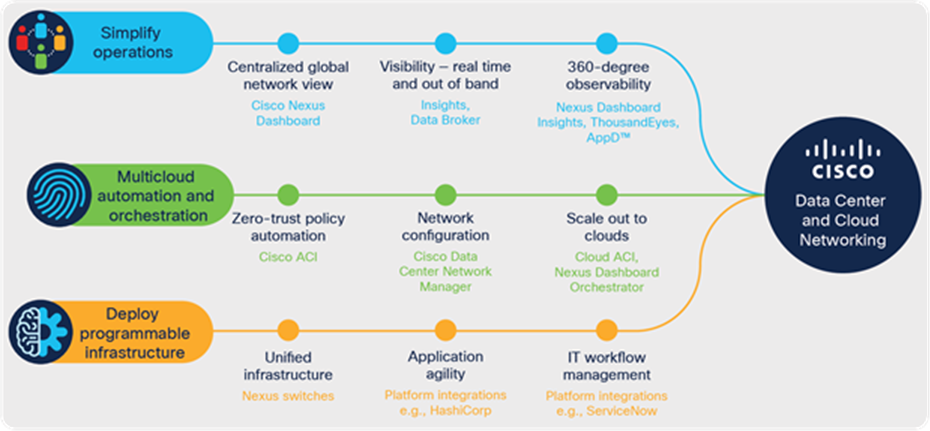
Getting started with Cisco Data Center and Cloud Networking
You can accelerate the journey to digitization by unlocking your network’s full potential. Cisco Services can help. Find out all the ways we can help you accelerate your migration to an advanced network, while mitigating risk, with Cisco Services for Networking.
Cisco Networking platform integrations and ecosystem
Cisco Networking platforms integrate across a broad range of cloud, endpoint, IT, and security technology partner systems. Likewise, with traditionally siloed network domains, organizations need a holistic network infrastructure strategy across the entire enterprise network.
It should be possible for IT and business intent to be expressed in one domain and then exchanged, enforced, and monitored across all of them. Cisco’s open-platform strategy provides policy integrations between access, WAN, data center, and cloud domains.
For example, Cisco ACI® and Cisco SD-Access policy integration maps Cisco ACI’s application-based micro-segmentation in the data center with Cisco SD-Access’s user group-based segmentation across the campus and branch. Now security administrators can automate and manage end-to-end segmentation seamlessly with uniform access policies — from the user to the application. With such segmentation, policies can be set that allow IoT devices to access specific applications in the data center or allow only financial executives and auditors to access confidential data. This is just one example of how Cisco solutions are enabling consistent multidomain policy segmentation and assurance for end-to-end alignment to business intent.
In addition to simplifying NetOps and helping ensure full end-to-end monitoring and troubleshooting, Cisco Networking platforms integrate with the Cisco ThousandEyes internet and cloud monitoring system so that problems can be quickly identified and rectified regardless of whether the problem occurs on the private or public network.
Why should you look to Cisco as your trusted partner to support you on your network transformation journey?
Cisco is the only vendor with the enterprise-wide strategy and architecture to deliver on the vision of closed-loop intent-based networking across every domain (access, WAN, data center, and cloud). Only Cisco intent-based networking provides the flexibility, simplicity, and confidence your organization needs to power its digital future:
Flexibility
● Adopt a flexible architecture that allows you to continuously align to your organization’s evolving needs.
● Choose the platform, hardware, software, and technology consumption model that best meets your scalability, capabilities, operations, and application needs.
● Support current and future needs with open platform extensibility that allows you to evolve your network capabilities at the pace of your business.
Simplicity
● IBN closed-loop insights and automation enable a sustainable and simplified operations model that reduces costs and frees up resources to drive innovation and value.
● AI/ML and machine reasoning help simplify and streamline operations so that problems can be identified and fixed quickly and proactively.
● Open platform integrations streamline IT and security workflows so that you can smoothly integrate into current environments.
Confidence
● Affords business leaders the possibility to support any new initiative with the knowledge that the network is an enabler rather than an obstacle.
● Gives IT the confidence to address the increasingly complex IT and technology landscape with an operating and security model that is sustainable and effective.
● Provides the security team the confidence that the network can be counted on to help them protect users, applications, and data.
Cisco’s open platform intent-based networking solutions are powered by a global ecosystem of half a million developers, 300,000 sellers, and 62,000 partners.
● Get started on your Cisco Networking journey at www.cisco.com/go/networking.
● Get started on your intent-based networking journey at cisco.com/go/ibn.
● Ask your sales representative about intent-based networking demos.
 Feedback
Feedback